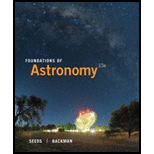
Foundations of Astronomy
13th Edition
ISBN: 9781305079151
Author: Michael A. Seeds, Dana Backman
Publisher: Cengage Learning
expand_more
expand_more
format_list_bulleted
Textbook Question
Chapter 26, Problem 7P
If you detected radio signals with an average wavelength of 20.000 cm and suspected that they came from a civilization on a distant Earth-like exoplanet, roughly how much of a change in wavelength should you expect to detect as a result of the orbital motion of the distant exoplanet? (Hint: Use the Doppler shift formula, Eq. 7-3.) (Note: Earth’s orbital velocity is 30 km/s.)
Expert Solution & Answer
Want to see the full answer?
Check out a sample textbook solution
Students have asked these similar questions
3
Set
ба
||Axl
49.32
6b
71
Ay
22
Magnitude of A
Angle of A
24.04
Angle of -A
22
54
155.96
° (pos Ax) 204.04
° (neg Ax) 335.96
°
(pos Ax)
° (neg Ax)
115.77
° (pos Ax) 295.77
° (pos Ax)
-39
81
208.78
° (neg Ax) 28.78
°
(neg Ax)
3AA . not sure what i am getting wrong
Chapter 26 Solutions
Foundations of Astronomy
Ch. 26 - Explain how astrobiology is a science and not a...Ch. 26 - Prob. 2RQCh. 26 - Prob. 3RQCh. 26 - How does the DNA molecule produce a copy of...Ch. 26 - What would happen to a life-form if the genetic...Ch. 26 - What would happen to a life-form if the genetic...Ch. 26 - What would happen to a life-form if the...Ch. 26 - Describe an example of natural selection acting on...Ch. 26 - Prob. 9RQCh. 26 - What evidence do scientists have that life on...
Ch. 26 - Prob. 11RQCh. 26 - Why is liquid water generally considered necessary...Ch. 26 - Prob. 13RQCh. 26 - What is the difference between chemical evolution...Ch. 26 - Prob. 15RQCh. 26 - Why was Earths early atmosphere able to support...Ch. 26 - Molecules of which gas were needed in Earths...Ch. 26 - Does intelligence make a creature more likely to...Ch. 26 - Prob. 19RQCh. 26 - Prob. 20RQCh. 26 - What is the evidence that the first organisms on...Ch. 26 - Name three locations in our Solar System to search...Ch. 26 - Why are upper-main-sequence (high-luminosity) host...Ch. 26 - Prob. 24RQCh. 26 - How does the stability of technological...Ch. 26 - Prob. 26RQCh. 26 - Prob. 27RQCh. 26 - Why are scientists confident Earth has never been...Ch. 26 - Why does the Drake equation implicitly assume the...Ch. 26 - Prob. 1DQCh. 26 - Prob. 2DQCh. 26 - Prob. 3DQCh. 26 - Prob. 4DQCh. 26 - Prob. 5DQCh. 26 - A single human cell encloses about 1.5 m of DNA....Ch. 26 - If you represent Earths history by a line that is...Ch. 26 - Consider Figure 25-8. What is the ratio of the...Ch. 26 - Suppose a human generation is defined as the...Ch. 26 - If a star must remain on the main sequence for at...Ch. 26 - Prob. 6PCh. 26 - If you detected radio signals with an average...Ch. 26 - Prob. 8PCh. 26 - The first radio broadcast was made on January 13,...Ch. 26 - Prob. 10PCh. 26 - Look at Figure 25-11. Since the time we sent the...Ch. 26 - The star cluster shown in this image contains a...Ch. 26 - If you could search for life in the galaxy shown...
Knowledge Booster
Learn more about
Need a deep-dive on the concept behind this application? Look no further. Learn more about this topic, physics and related others by exploring similar questions and additional content below.Similar questions
arrow_back_ios
SEE MORE QUESTIONS
arrow_forward_ios
Recommended textbooks for you
 Stars and Galaxies (MindTap Course List)PhysicsISBN:9781337399944Author:Michael A. SeedsPublisher:Cengage Learning
Stars and Galaxies (MindTap Course List)PhysicsISBN:9781337399944Author:Michael A. SeedsPublisher:Cengage Learning
 Foundations of Astronomy (MindTap Course List)PhysicsISBN:9781337399920Author:Michael A. Seeds, Dana BackmanPublisher:Cengage Learning
Foundations of Astronomy (MindTap Course List)PhysicsISBN:9781337399920Author:Michael A. Seeds, Dana BackmanPublisher:Cengage Learning
 Stars and GalaxiesPhysicsISBN:9781305120785Author:Michael A. Seeds, Dana BackmanPublisher:Cengage Learning
Stars and GalaxiesPhysicsISBN:9781305120785Author:Michael A. Seeds, Dana BackmanPublisher:Cengage Learning AstronomyPhysicsISBN:9781938168284Author:Andrew Fraknoi; David Morrison; Sidney C. WolffPublisher:OpenStax
AstronomyPhysicsISBN:9781938168284Author:Andrew Fraknoi; David Morrison; Sidney C. WolffPublisher:OpenStax

Stars and Galaxies (MindTap Course List)
Physics
ISBN:9781337399944
Author:Michael A. Seeds
Publisher:Cengage Learning


Foundations of Astronomy (MindTap Course List)
Physics
ISBN:9781337399920
Author:Michael A. Seeds, Dana Backman
Publisher:Cengage Learning


Stars and Galaxies
Physics
ISBN:9781305120785
Author:Michael A. Seeds, Dana Backman
Publisher:Cengage Learning

Astronomy
Physics
ISBN:9781938168284
Author:Andrew Fraknoi; David Morrison; Sidney C. Wolff
Publisher:OpenStax
Kepler's Three Laws Explained; Author: PhysicsHigh;https://www.youtube.com/watch?v=kyR6EO_RMKE;License: Standard YouTube License, CC-BY